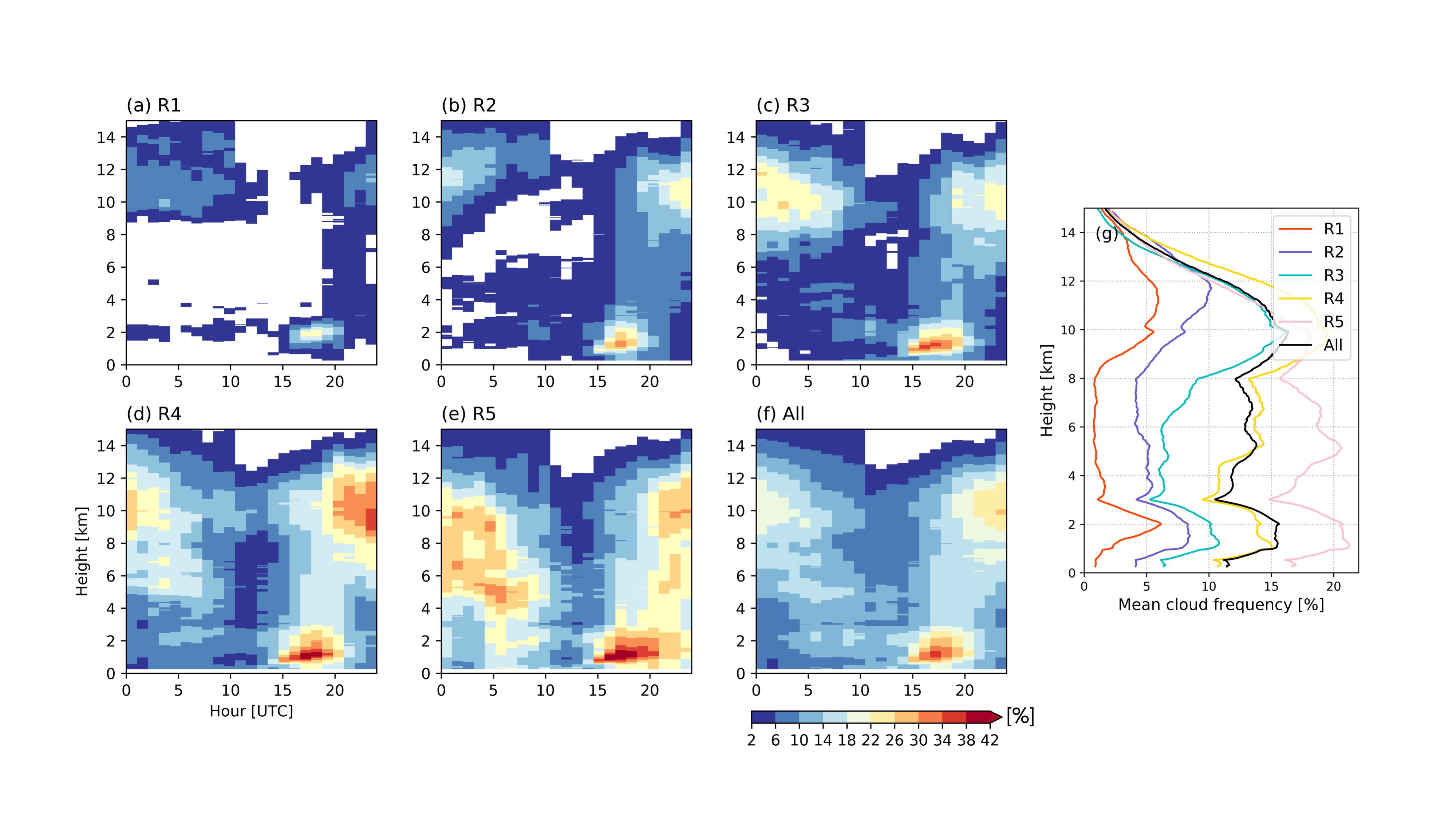New perspectives on cloud regimes over the Amazon Basin
Submitter
Giangrande, Scott — Brookhaven National Laboratory
Wang, Die — Brookhaven National Laboratory
Area of Research
Cloud Processes
Journal Reference
Giangrande S, D Wang, and D Mechem. 2020. "Cloud regimes over the Amazon Basin: perspectives from the GoAmazon2014/5 campaign." Atmospheric Chemistry and Physics, 20(12), 10.5194/acp-20-7489-2020.
Science

Figure 1. The diurnal cycle of hourly mean cloud frequency (when cloud coverage >2 %) as a function of height for each regime (a–f) according to multi-instrument cloud profiling retrieval. The mean 1h cloud frequency profiles are shown in (g). From journal.
The assumptions underpinning climate model cloud-process representations are often poorly constrained by observations, especially cloud properties found in remote/under-sampled global locations. Untangling cloud–climate controls in ways suitable for ongoing model development therefore demands long-term, multi-scale, multi-sensor observations from challenging instrument deployments to capture cloud properties -- such as the recently completed U.S. Department of Energy Atmospheric Radiation Measurement (ARM) GoAmazon2014/15 campaign. As home to the largest tropical rain forest on the planet, the Amazon Basin experiences prolific and diverse cloud conditions that vary according to pronounced changes in seasonal regimes. However, these clouds, regimes, and their associated convective intensity are interconnected, with cloud properties strongly influenced by (and influencing, via feedbacks) seasonal shifts in the thermodynamic forcing, as well as larger-scale atmospheric Hadley and Walker circulation variability.
Impact
The primary atmospheric regimes observed during the heavily instrumented two-year GoAmazon2014/15 deployment are classified using automated clustering techniques. We assess the potential atmospheric controls on convective clouds and precipitation, as well as the propensity for these regimes to favor mesoscale convective systems (MCSs). Overall, we find reduced cloud cover and precipitation rates to be associated with regimes with lowest humidity and the highest convective inhibition. Approximately one fifth of the campaign days were influenced by MCSs, with these events predominantly contained within the transitional (between wetter and drier) regime periods.
Summary
To provide information on the potential controls for clouds experienced over the Amazon Basin, a cluster analysis was performed on routine radiosonde profiles collected during GoAmazon2014/15. This effort follows previous applications of k-means cluster methods to objectively define large-scale cloud and precipitation controls from traditional calendar-driven wet/dry season definitions. We identified five primary thermodynamic regimes and explored these states in the context of those traditional Amazon definitions, composite large-scale synoptic patterns, and model forcing data sets. Column and scanning radar observations were projected onto these states, highlighting the propensities for each state to promote different cloud types, frequencies, and changes to precipitation. MCSs were most frequently associated with transitional regimes.
Keep up with the Atmospheric Observer
Updates on ARM news, events, and opportunities delivered to your inbox
ARM User Profile
ARM welcomes users from all institutions and nations. A free ARM user account is needed to access ARM data.


















